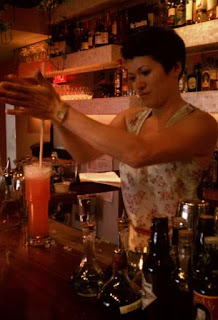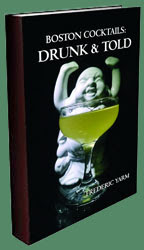
This month's
Mixology Monday theme, "Local Color" (MxMo LXI), was picked by Lindsay of the
Alcohol Alchemy blog. Lindsay's challenge was for people to focus on their local craft spirit scene.
The last time we did a local themed Mixology Monday was back in 2008 and the concept was "local flavor" that did not necessarily focus on spirits but to "gather ingredients that are representative of the culture/geography/tackiness of your respective cities and make a drink with a truly place-based style." I took the tacky part of that description as a dare and bought some horrid vodka produced here in
Somerville, MA, and I soothed it with cucumber and herbs from my garden. While there were much better spirits being made in Massachusetts back then, I figured that closer to home was better.
Since that time, a few more local distilleries have opened up. One of these newer ones that I was impressed with is the Ryan & Wood Distillery up in Gloucester, MA. We have been mixing with their
Knockabout Gin for almost a year and a half now, and they also have a rum and a vodka. Recently, they just released their straight rye, and local food and drink writer
MC Slim JB spoke highly about it. Therefore, a few days ago, I stopped into Atlas Liquors and bought a bottle of the rye that had come from the distillery's very first barrel. When Andrea and I tasted it, it had a pine-spice and caramel nose. The sip started a little thinly flavored but with a fuller mouthfeel; most of the flavor was in the mid and back palate especially with caramel and spice on the swallow. As MC Slim had mentioned, this is a not a rye that would easily be lost in a cocktail. If I were to compare it to a better known whiskey, I would liken it to a more flavorful Sazerac 6 Year Rye.
For the first local themed Mixology Monday, I bandied about the idea of doing the Boston classic, the Ward 8. I probably chose not to do that recipe since the drink generally comes across as an unremarkable Whiskey Daisy. However, when my old college friend was in town back in April, I took her to Drink and bartender Joe Staropoli made her a Ward 8 that was pretty amazing. Between the inside of the wine glass being rubbed with mint, the crushed ice, the drizzling of grenadine over the final drink, and the mint and orange spiral twist garnishes, the Ward 8 was an act of love and beauty, and not just a way of softening the whiskey.
The next time I was at Drink, I asked bar manager John Gertsen about it, and he said that it was their take on the specific Ward 8 recipe that David Wondrich recommended in
Imbibe!. Not remembering now the exact recipe that Drink used and wanting to change up Wondrich's recipe slightly to include what I did remember and some of my own preferences, this recipe is an unique hybrid.

Since Wondrich's book is in front of me, I will start with a recap of the drink history that he provided. The drink was created at Boston's Locke-Ober restaurant for a political victory party held for someone running for some office or other in the eighth ward. Some reports take the drink back to 1898, but grenadine was not frequently used until after 1910. With perhaps some support for the drink-riddled voting stories in Christine Sismondo's
America Walks into a Bar, a 1918 novel declared that after one of these "you're ready to vote right."
Ward 8
• 3/4 oz Lemon Juice
• 3/4 oz Orange Juice
• 1 barspoon (1/8 oz) Sugar
• 2 oz Rye (Ryan & Wood)
• 3/8-1/2 oz Grenadine
Stir juice with sugar until the crystals dissolves. Add rye, shake with ice, and strain into a wine glass that had its inside rubbed with a mint sprig and then filled with crushed ice. Drizzle the grenadine over the top so it will cascade down to the bottom of the glass. Garnish with a fresh mint sprig and an orange peel spiral twist, and add a straw.
From the beautiful garnishes on top to the attractive red layer on the bottom, this Wondrich-Drink Ward 8 that I have adapted is quite stunning. The garnishes provided a mint and orange aroma. The sip was a crisp orange flavor that was followed by rye and lemon on the swallow. In addition, the mint used to coat the interior of the glass provided some pleasant notes on the finish.
So cheers from Boston to Lindsay for leading the political rally this month and for Paul Clarke for masterfully rigging the election just so!










 This month's
This month's 






 Peel 3-4 celery roots (1/2 celery root) and cut into thin slices.
Peel 3-4 celery roots (1/2 celery root) and cut into thin slices.




 2 oz Linie Aquavit
2 oz Linie Aquavit



















 The 2017 collection of 855 drink recipes, bartender tributes, and essays on hospitality from CocktailVirgin's Frederic Yarm. Available at
The 2017 collection of 855 drink recipes, bartender tributes, and essays on hospitality from CocktailVirgin's Frederic Yarm. Available at  The 2012 collection of 505 drink recipes, techniques, and Boston bar recommendations from Frederic Yarm. Available at
The 2012 collection of 505 drink recipes, techniques, and Boston bar recommendations from Frederic Yarm. Available at 



